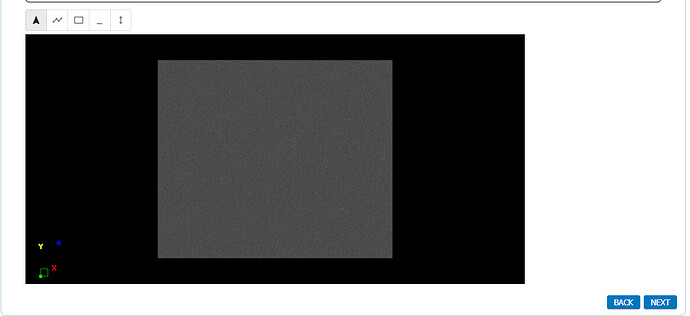Hello ,
I am trying to add axes actor to my vtk.js viewer component. I am then trying to use the axesActor to rotate the scene in y axis by 180 degree. I have created an instance of orientation widget and added the axesActor as actor to the widget. The issue is by adding “widgetManager.setRenderer(operationRenderer);” to the code, any other widget that I create is limited to the “operationRenderer”, which in my case is the small box holding the axesActor at the bottom left corner(screen shot attached). For example when i create a rectangle widget, it is created on that small left corner box. I want the axesActor to flip the actor in the parent renderer or the main screen and not the orientationWidget renderer.
Please provide suggestions. Appreciate all the help.
///----------------trigger flip/rotate axis-----------
const handleFlipAxis = () => {
console.log(" axis Handle flip run");
const { axesActor, orientationWidget } = sceneLiveFrame;
axesActor.rotateWXYZ(180, 0, 1, 0);
};
//----------------creating the live viewer---------------
export const createLiveFrameScene = (
container,
dataArray,
colorMap,
maskDataArray,
opacityFunction
) => {
const renderWindow = vtkRenderWindow.newInstance({
rootContainer: container,
});
const renderer = vtkRenderer.newInstance();
const render = renderWindow.render;
renderWindow.addRenderer(renderer);
const openglRenderWindow = vtkOpenGLRenderWindow.newInstance();
openglRenderWindow.setContainer(container);
const { width, height } = container.getBoundingClientRect();
openglRenderWindow.setSize(width, height);
renderWindow.addView(openglRenderWindow);
const interactor = vtkRenderWindowInteractor.newInstance();
interactor.setView(openglRenderWindow);
interactor.initialize();
interactor.bindEvents(container);
// mapper and actor
const actorImage = vtkImageSlice.newInstance();
const mapperImage = vtkImageMapper.newInstance();
const interactorStyle = vtkInteractorStyleManipulator.newInstance();
// // InteractionPresets.applyPreset('2D', interactorStyle);
interactor.setInteractorStyle(interactorStyle);
// enable zoom in / zoom out
const zoomManipulatorMiddleButton =
vtkMouseCameraTrackballZoomManipulator.newInstance();
zoomManipulatorMiddleButton.setButton(2); // Middle Button
interactorStyle.addMouseManipulator(zoomManipulatorMiddleButton);
const zoomManipulatorScroll =
vtkMouseCameraTrackballZoomManipulator.newInstance();
zoomManipulatorScroll.setDragEnabled(false);
zoomManipulatorScroll.setScrollEnabled(true);
interactorStyle.addMouseManipulator(zoomManipulatorScroll);
const zoomManipulatorLeft =
vtkMouseCameraTrackballZoomManipulator.newInstance();
zoomManipulatorLeft.setButton(1); // Left Button
zoomManipulatorLeft.setControl(true);
interactorStyle.addMouseManipulator(zoomManipulatorLeft);
// enable pan
const panManipulatorRightMouse =
vtkMouseCameraTrackballPanManipulator.newInstance();
panManipulatorRightMouse.setButton(3); // Right button
interactorStyle.addMouseManipulator(panManipulatorRightMouse);
const panManipulatorLeftMouse =
vtkMouseCameraTrackballPanManipulator.newInstance();
panManipulatorLeftMouse.setButton(1); // Left button
panManipulatorLeftMouse.setShift(true);
interactorStyle.addMouseManipulator(panManipulatorLeftMouse);
**********Adding the axes actor to represent the x and y axis of the live image viewer*********
// Setup axes
const axesActor = vtkAxesActor.newInstance();
const orientationWidget = vtkOrientationMarkerWidget.newInstance({
actor: axesActor,
interactor: interactor,
renderer: renderer,
});
const operationRenderer = orientationWidget.getRenderer();
orientationWidget.setParentRenderer();
orientationWidget.setEnabled(true);
orientationWidget.setViewportCorner(
vtkOrientationMarkerWidget.Corners.BOTTOM_LEFT
);
orientationWidget.setViewportSize(0.1);
orientationWidget.setMinPixelSize(100);
orientationWidget.setMaxPixelSize(300);
console.log('axes', axesActor, );
const widgetManager = vtkWidgetManager.newInstance();
widgetManager.setRenderer(renderer);
*//----**************************suspected cause of problem**********************----------
widgetManager.setRenderer(operationRenderer);
axesActor.onModified(() => {
// Get the orientation matrix of the axes actor
console.log("axes actor modified");
const orientationMatrix = axesActor.getMatrix();
const axesOrientation = axesActor.getOrientation();
const matrix = vtkMatrixBuilder.buildFromDegre(0,0,0);
console.log('axes matrix', matrix);
// Extract the y-axis of the orientation matrix
const yAxis = [
orientationMatrix[1],
orientationMatrix[5],
orientationMatrix[9],
];
console.log("yAxis MATRIX", orientationMatrix, yAxis);
// Check if the y-axis is pointing down (y < 0)
if (yAxis[1] < 0) {
// Flip the scene
flipScene(camera, widgetManager, renderWindow, orientationWidget);
axesActor.setMatrix(orientationMatrix);
// console.log('newMatrix', newMatrix);
}
});
